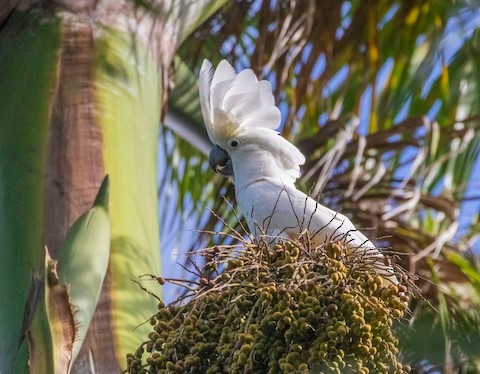Birdfinding.info ⇒ The White Cockatoo is severely persecuted for the illegal cagebird trade, and is becoming endangered as a result. Although it has declined rapidly, populations remain in several parts of Halmahera, including relatively accessible areas such as Kali Batu Putih in the west, Aketajawe-Lolobata National Park in the east, and Weda in the south. An introduced flock in Puerto Rico can often be found in the Tintillo Hills neighborhood east of Julio Enrique Monaga National Park.
White Cockatoo
Cacatua alba
Endemic to Indonesia’s Bacan Islands: Halmahera and the adjacent islands of Bacan, Ternate, Tidore, Kasiruta, and Mandioli, where it occurs in all forest types, in lowlands and foothills up to around 900 m elevation.
In Puerto Rico, a flock numbering up to 15 individuals has inhabited the Tintillo Hills neighborhood of Bayamón since the mid-1990s.
An introduced population has been reported as established on Taiwan—however, surveys of exotic cockatoos on the island in 1998-2000 found only four Whites, which suggests that it is unlikely to be self-sustaining.
Identification
A large white cockatoo with a luxuriant all-white crest—which has inspired the aviculturist name Umbrella Cockatoo.
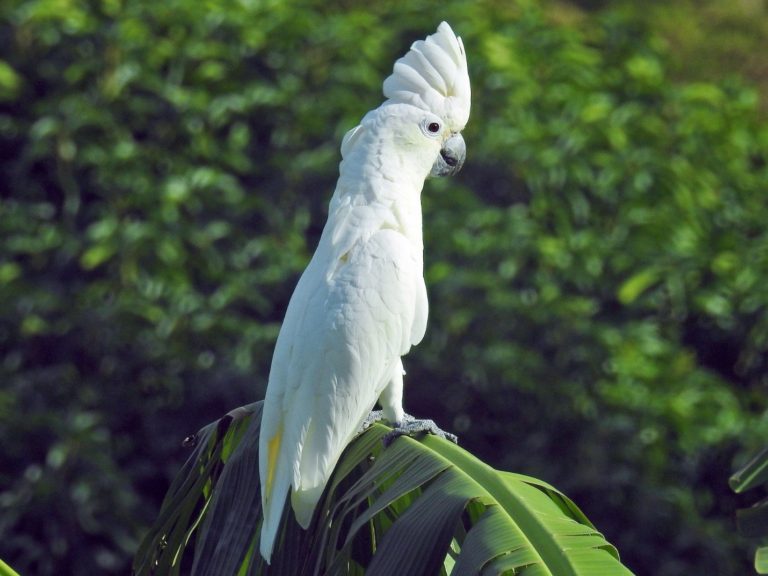
White Cockatoo with its all-white crest raised—note that this is an isolated feral individual. (Wilhelmina Rise, Honolulu, Hawaii; December 7, 2016.) © Satoko Lincoln
The plumage is entirely white except for the undersides of the wings and tail, which are suffused with yellow (a feature shared with other white cockatoos).
Males and females differ in the color of their irises: dark brown in males, reddish in females.

White Cockatoo, showing that it can also appear off-white. (Weda, Halmahera, Indonesia; September 28, 2016.) © Simon van der Meulen
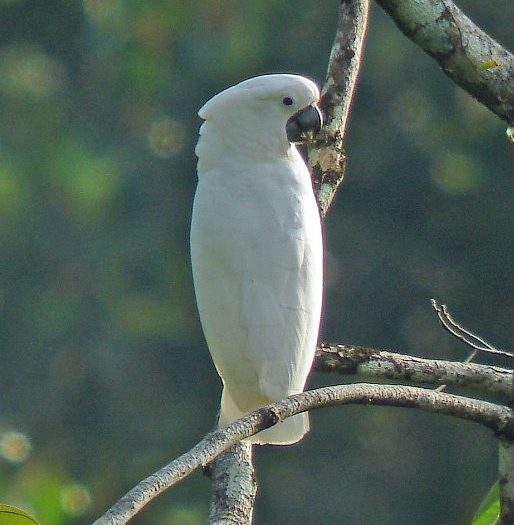
White Cockatoo with its all-white crest flattened. (Foli, Halmahera, Indonesia; September 13, 2007.) © Pete Morris / Birdquest
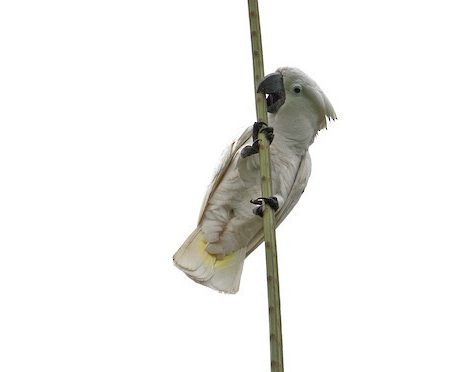
White Cockatoo—note its enormous bill and the yellowish wash on the undertail. (Maluku Utara, Indonesia.) © Sam Woods

White Cockatoo, dorsal view in flight. (Weda, Halmahera, Indonesia; August 31, 2015.) © Sam Woods / Tropical Birding Tours
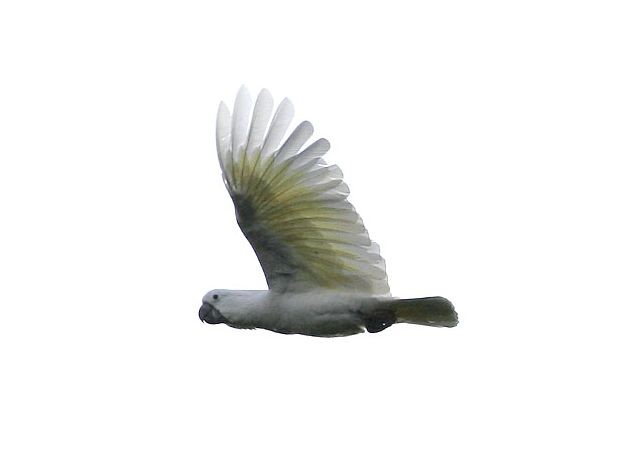
White Cockatoo, ventral view in flight, showing yellow tint on underwing. (Halmahera, Indonesia; May 28, 2006.) © Ong Kiem Sian
Voice. Typical calls are harsh, hoarse, guttural barks, given in series: Bacan, Indonesia; November 1991. © Frank Lambert
Often calls insistently, incessantly for minutes at a time: Bacan, Indonesia; November 1991. © Frank Lambert
Alternative calls include mournful trumpeting: Kali Batu Putih, Halmahera, Indonesia. © Peter Roskams; and Halmahera, Indonesia. © Filip Verbelen
Notes
Monotypic species.
IUCN Red List Status: Endangered.
See below for comparisons of White Cockatoo with Salmon-crested Cockatoo, Tanimbar Corella, and Solomons Corella.
Cf. Salmon-crested Cockatoo. White and Salmon-crested Cockatoos are sibling species that are endemic to nearby island groups in the Moluccas—White to the Bacan Islands and Salmon-crested to Seram and its neighbors. They do not occur together naturally, but because both are popular cagebirds both have been found living ferally outside of their natural ranges, often in the same areas (e.g., Hawaii and Puerto Rico). Moreover, it appears that they may have hybridized at least once in Hawaii, potentially producing intermediate offspring.
They are approximately the same size, with similarly-shaped crests and similar coloration. The White Cockatoo is nearly all-white (with yellowish underwings and undertail) and Salmon-crested usually has a pinkish tone in its coloration (with pinkish, orangish, or yellowish underwings and undertail), but the tones of both species vary and viewing conditions make subtle differences in tone unreliable for identification. The only consistent difference is the presence or absence of pink in the crest—however, this is sometimes concealed, and hybrid offspring are also likely to show some pink in the crest, so even the crest coloration is somewhat unreliable for identification.
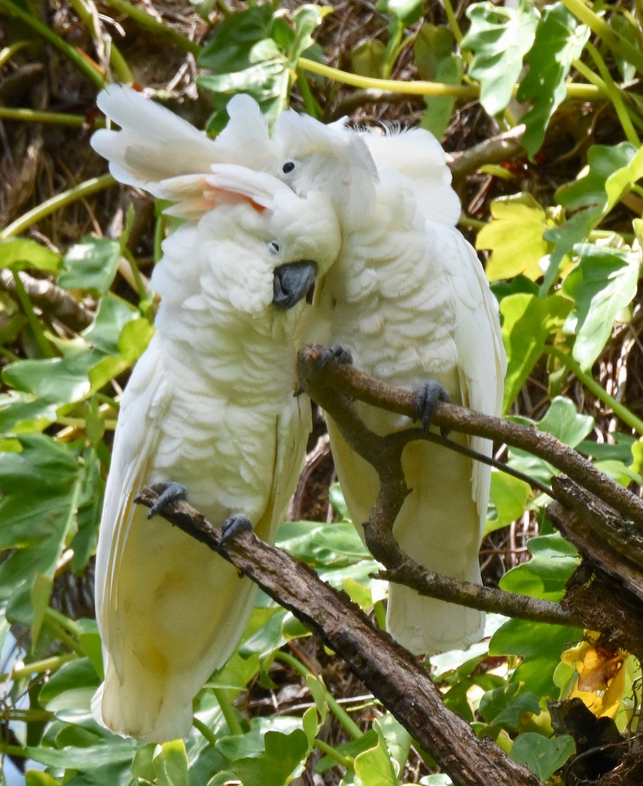
Salmon-crested Cockatoo (at left) with a White Cockatoo preening it—apparently a mated pair. (Lyon Arboretum, Honolulu, Hawaii; August 16, 2018.) © Walter Oshiro
Cf. Tanimbar Corella. White Cockatoo and Tanimbar Corella are similar species that are endemic to nearby islands in eastern Indonesia. They do not occur together naturally, but as popular cagebirds both could occur nearly anywhere, and both have been found in feral mixed-species flocks in Hawaii, Singapore, and Taiwan.
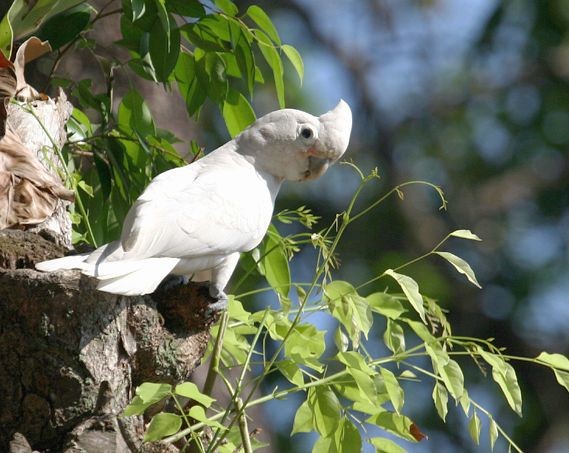
Tanimbar Corella, appearing nearly all-white—note horn-colored bill and pink feathers in the lores. (Changi, Singapore; April 15, 2005.) © Mervin Quah
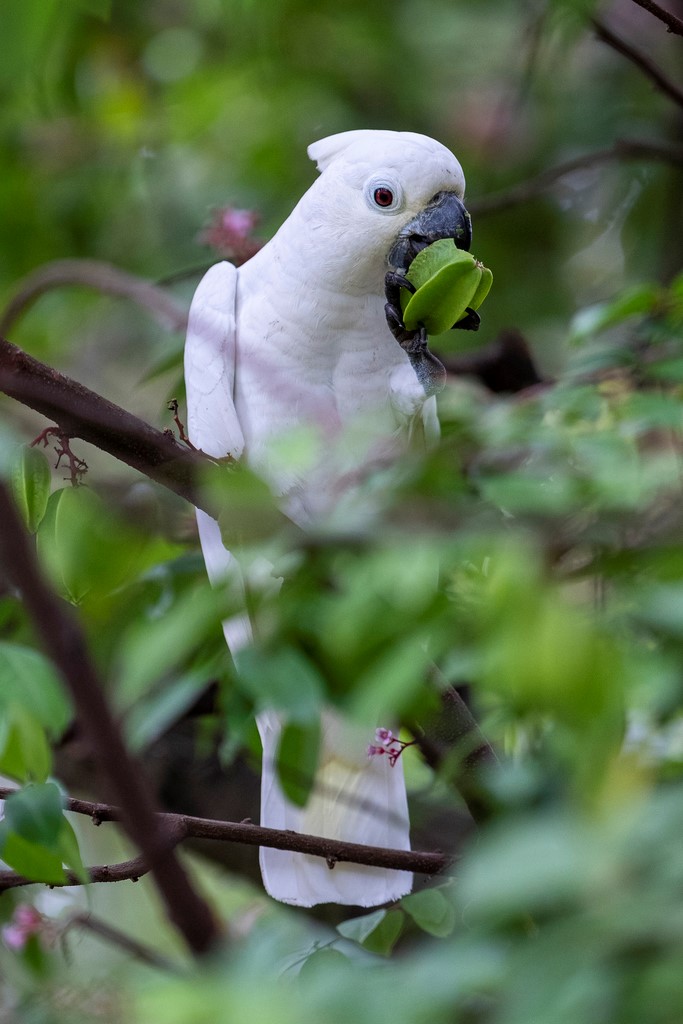
White Cockatoo, apparently a young bird with a short crest—appearing much like a Tanimbar Corella, but note the black bill with all-white feathering around its base. (Singapore; December 2019.) © Bryan Yeung
Both are mostly white and have conspicuous, saucer eyes—a big-eyed impression caused by their white orbital skin. White Cockatoo is somewhat larger overall, with longer crest feathers, and Tanimbar Corella usually has a detectable pinkish blush in its plumage. However, White Cockatoos sometimes appear off-white, and younger individuals can have shorter crests, whereas Tanimbar Corella sometimes appears white overall. The clearest difference between them is bill color: black on White Cockatoo and ivory or horn-colored on Tanimbar Corella. Also, Tanimbar Corella generally has detectable dull-pink coloration around the base of the bill, especially on the lores.
Cf. Solomons Corella. White Cockatoo and Solomons Corella are both essentially all-white cockatoos. They do not occur together naturally, but as popular cagebirds both could occur nearly anywhere. White Cockatoo is somewhat larger, with a longer crest (but short on some immatures) and white orbital skin—whereas Solomons’ is grayish or bluish. The most consistent diagnostic difference is bill color: black on White Cockatoo and ivory or horn-colored on Solomons Corella.
Additional Photos of White Cockatoo
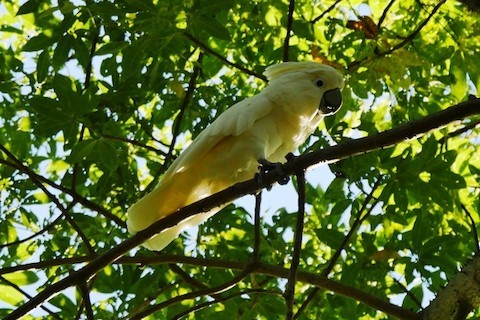
White Cockatoo, appearing yellow overall in this lighting. (Mayagüez, Puerto Rico; February 3, 2017.) © Sadhu Govardhan
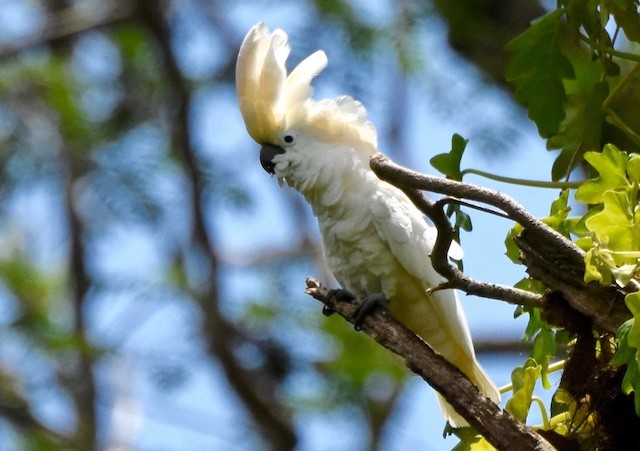
White Cockatoo with its crest raised. (Lyon Arboretum, Honolulu, Hawaii; May 17, 2018.) © Walter Oshiro

White Cockatoo. (Valle del Sol, Bayamón, Puerto Rico; May 30, 2021.) © Frances M. Santiago Tomei
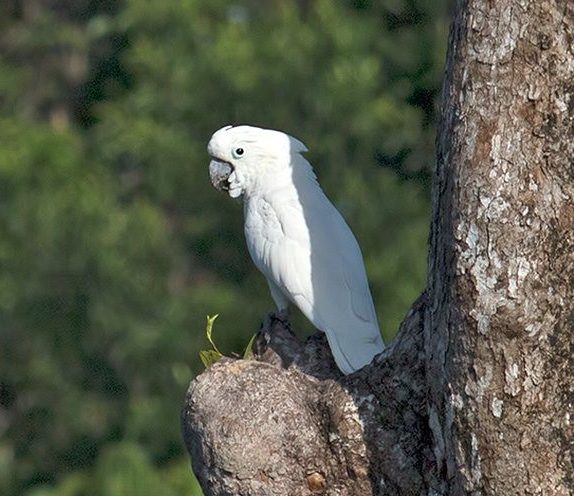
White Cockatoo. (Weda, Halmahera, Indonesia; September 3, 2015.) © Sam Woods / Tropical Birding Tours
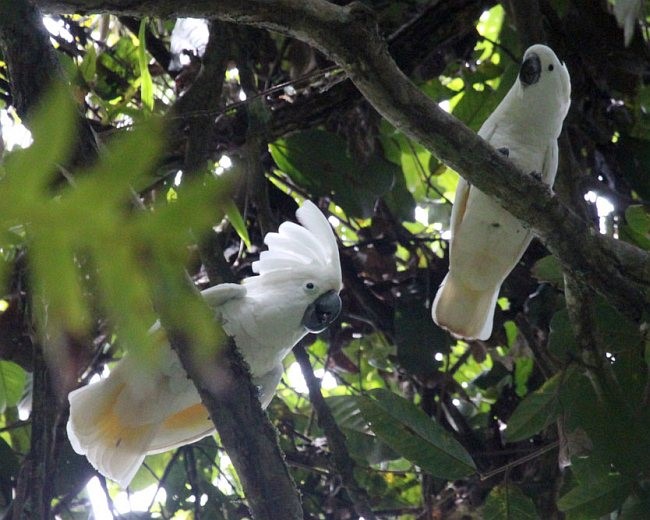
White Cockatoo, pair. (Namonamo, Aketajawe Lolobata National Park, Halmahera, Indonesia; March 3, 2012.) © Hanom Bashari

White Cockatoo, showing yellowish tint in undertail. (Maluku Utara, Indonesia.) © Scott Baker
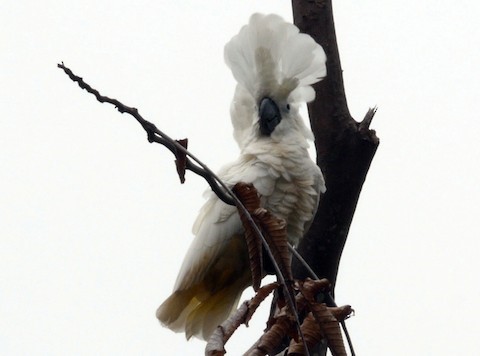
White Cockatoo with its crest raised. (Maluku Utara, Indonesia.) © Josep del Hoyo

White Cockatoo. (Julio Enrique Monaga National Park, Bayamón, Puerto Rico; March 20, 2021.) © Amarilys Lebron

White Cockatoo, showing yellowish tint in undertail. (Manila Polo Club, Makati, Luzon, Philippines; April 10, 2020.) © Ramon Quisumbing
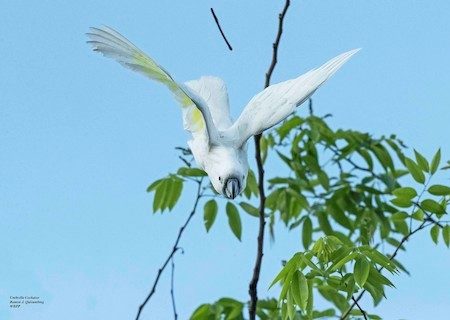
White Cockatoo showing yellow tint on underwing. (Manila Polo Club, Makati, Luzon, Philippines; April 10, 2020.) © Ramon Quisumbing
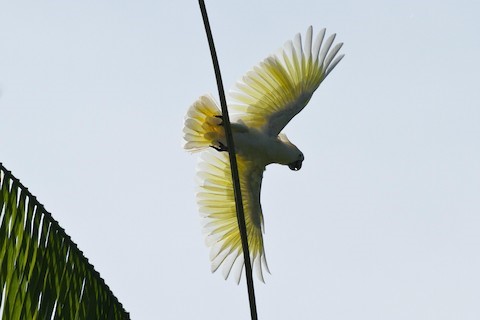
White Cockatoo showing yellow tint on underwings and undertail. (Maluku Utara, Indonesia.) © Eric VanderWerf
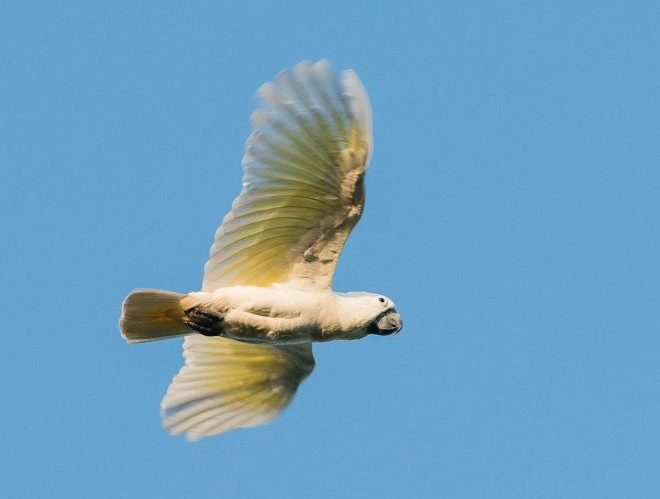
White Cockatoo showing yellow tint on underwings and undertail. (Weda, Halmahera, Indonesia; September 29, 2014.) © Simon van der Meulen
References
BirdLife International. 2018. Cacatua alba. The IUCN Red List of Threatened Species 2018: e.T22684789A131915204. https://dx.doi.org/10.2305/IUCN.UK.2018-2.RLTS.T22684789A131915204.en. (Accessed August 1, 2021.)
Brazil, M. 2009. Birds of East Asia. Princeton University Press.
eBird. 2021. eBird: An online database of bird distribution and abundance. Cornell Lab of Ornithology, Ithaca, N.Y. http://www.ebird.org. (Accessed August 1, 2021.)
Forshaw, J.M. 2010. Parrots of the World. Princeton University Press.
Juniper, T., and M. Parr. 1998. Parrots: A Guide to Parrots of the World. Yale University Press.
Kirwan, G.M., A. Levesque, M. Oberle, and C.J. Sharpe. 2019. Birds of the West Indies. Lynx Edicions, Barcelona.
Lin, R.S. and P.F. Lee. 2006. Status of Feral Populations of Exotic Cockatoos (Genus Cacatua) in Taiwan. Tawania 51:188-194.
Michigan State University. 2021. AVoCet: Avian Vocalizations Center. https://avocet.integrativebiology.natsci.msu.edu/. (Accessed August 1, 2021.)
Pyle, R.L., and P. Pyle. 2017. The Birds of the Hawaiian Islands: Occurrence, History, Distribution, and Status. Version 2 (January 1, 2017). http://hbs.bishopmuseum.org/birds/rlp-monograph/. B.P. Bishop Museum, Honolulu, Hawaii.
